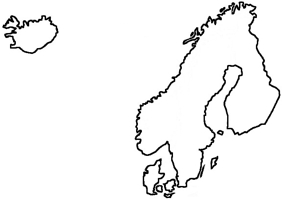
|
The Society of Folk Dance Historians (SFDH)
Scandinavian Impressions
[
Home |
About |
Encyclopedia | CLICK AN IMAGE TO ENLARGE |

|
PRONUNCIATION
 The Scandinavian languages share many characteristics. In all of them the letter "j" is pronounced as "y" in English, and "w" is pronounced as "v."
The Scandinavian languages share many characteristics. In all of them the letter "j" is pronounced as "y" in English, and "w" is pronounced as "v."
The letter "ø" in Norwegian and Danish, like the "ö" in Swedish, is pronounced like the "u" in "turn," and in Swedish "g" after "r" is usually silent (Hälsingborg is HELL-sing-bor).
In Norwegian and Swedish "skj" and "sj" are both "sh" (Bingsjö is BING-shuh).
The "å" in all three languages (sometimes written as "Åå" in Norwegian and Danish) is like the "o" in "ford" (Skåne is SKOH-nuh).
The "æ" in Danish is usually pronounced like "a" in "able," but "æ" in Norwegian is like "a" in "cat."
The "ä" in Swedish is pronounced like the "e" in "end" (Älvsborg is ELVS-bor).
NORWAY'S TWO LANGUAGES
The Norwegians carry their sense of individuality even into language. When the country was ceded by Denmark to Sweden in 1814, its official language was Riksmål, a Danish dialect mostly spoken by upper class townspeople. Many of the dialects spoken in rural areas stemmed, however, not from Danish but Old Norse, the language of the 13th Century sagas. These dialects had no written forms. While literary figures were urging that Riksmål be made "more Norwegian" by incorporating more Norwegian words into it, a patriotic philologist invented Landsmål, a language based on the rural dialects, and gave written forms to it. Spurred by nationalistic fervor, Landsmål quickly caught on, and the government was forced to make it, also, an official language. Today both languages are taught in the Norwegian schools, and Norway periodically simmers over the question of changing or modifying one or the other of them.
THE PREVENTION OF DISTRESS
Swedes talk of making their country into a "home for the people," and their social-welfare programs have attracted worldwide attention. There are, in fact, similar programs in Denmark and Norway. Danes speak of "the greatest possible happiness for the greatest number of people," and Norwegians of guaranteeing "security regardless of individual success."
The emphasis is on the prevention of distress rather than on its cure. Whereas in the United States aid is granted to indigent families with children to prevent the breakup of families for financial reasons, in Scandinavia mothers receive annual cash payments for each child under sixteen, regardless of the family's circumstances.
Using Sweden as an example, there is also free health supervision and preventive medicines to infants and children up to primary school age. Books and meals are supplied through primary and secondary school; tuition is free through college. Employed pregnant women receive six months maternity leave at two thirds pay. And there are many cash benefits which may be applied for if needed. All Swedes belong to a government-administered health insurance plan and there are many free hospital and retirement benefits.
Denmark and Norway spend about thirteen percent of their national incomes on welfare, Sweden a trifle more. The United States, by comparison, spends about six percent. Despite their size, the welfare programs in Scandinavia are conducted with a minimum of friction due to mutual trust and honesty in administrators and recipients of the aid.
THE VIKING AGE
If Scandinavians today are peaceable, using their energy for the public good, their ancestors were among the most feared men of the sword that the world has ever seen. First in small bands and then in large disciplined striking forces, the Vikings completely subjugated a good part of France and England and pillaged and terrorized much of the rest of the then known world. Little enough remains of the Viking's impressive and warlike culture, but what there is conjures up visions of brawny, bearded warriors of the sea braving death for plunder and power.
Viking raids and explorations ranged far and wide in the Eighth to Tenth Centuries. Most of these expeditions originated in the Scandinavian settlements of Nidaros (now Trondheim) and Skiringssal (near Oslo) in Norway, Birka (near Stockholm) in Sweden, and Hedeby (near Sønderborg) in Denmark. Some of the voyages were plundering raids, particularly in southern England and what is now France. Others – particularly those in eastern Europe and beyond – were for the purpose of setting up trade routes. Sometimes the warriors and traders stayed only a short time. But in Ireland, eastern England ("Danelaw"), the coastal regions of Germany and the Netherlands ("Frisia"), a large portion of northern France ("Normandy") and around the areas of Novgorod in Russia and Kiev in the Ukraine, they stayed for protracted periods, in time merging into and influencing the native populations.
In the end the rapacious Vikings faded into the history of other peoples. They were merchant adventurers on the grand scale, and it is this, as much as their fearlessness as seafarers and explorers, that gives the Viking Age its memorable place in history.
DOCUMENTS
- Denmark, a country.
- Dick Oakes, an article.
- England, a country.
- Finland, a country.
- Iceland, a country.
- Norway, a country.
- Scandinavia, a region.
- Sweden, a country.
From the Holiday Camp 1978 syllabus.
This page © 2018 by Ron Houston.
Please do not copy any part of this page without including this copyright notice.
Please do not copy small portions out of context.
Please do not copy large portions without permission from Ron Houston.